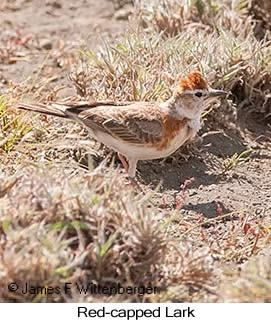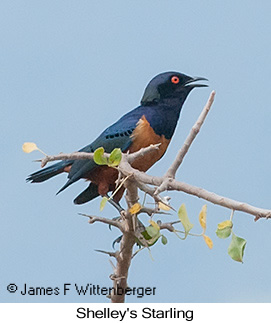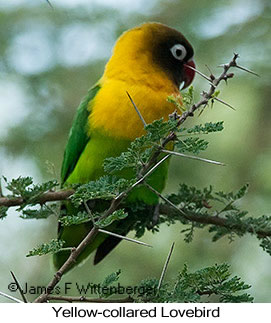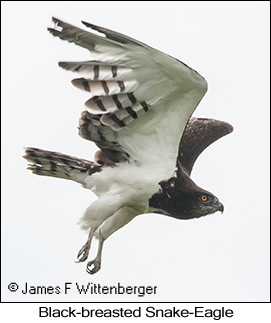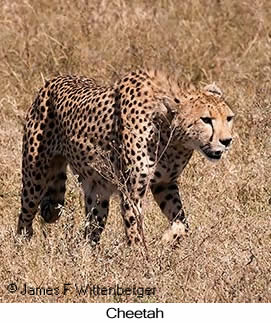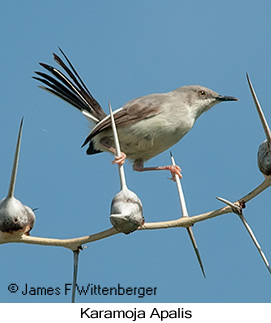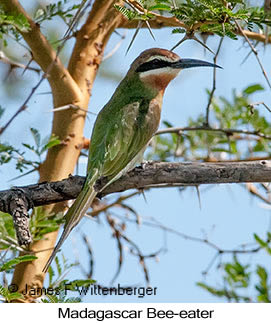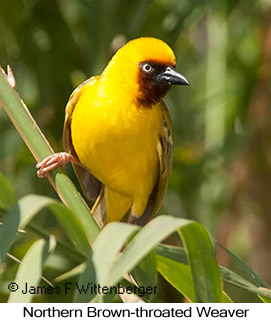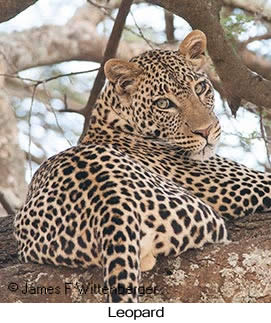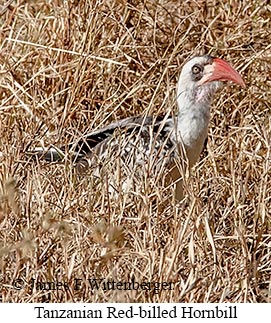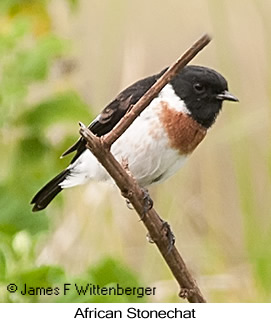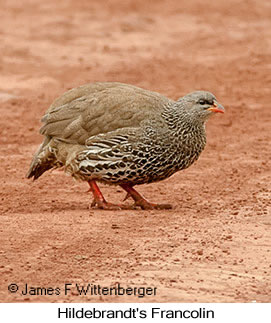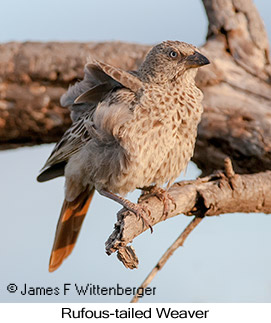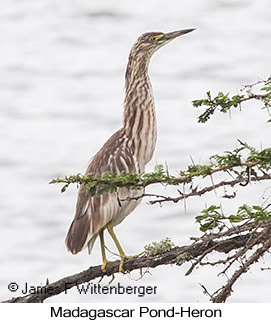TANZANIA BIRDING TRIP REPORT

TRIP REPORT
TANZANIA
| Start: | 05/19/2014 |
| End: | 05/31/2014 |
| Duration: | 13 days |
| #Species: | 334 |
| #Endemics: | 15 |
| #Heard Only: | 1 |
2014 Tanzania Birding & Mammal Safari
TOUR DESCRIPTION
Our scouting trip to Tanzania was organized by a land agent we'll be using in future to conduct tours there. It was broken into two segments, a typical birding safari itinerary to the major game parks and an extension to the South Pare and Usambara Mountains, which will be reported separately. The extension was originally supposed to include an overnight on Pemba Island, but due to changes in the schedule of available flights we cancelled that because we wouldn't have time to see all the endemics. In lieu of Pemba Island, we added an extra day to our stay in the Central Serengeti instead. We chose to visit Tanzania in mid-May because Pemba Island isn't worth visiting until early June after the rains and most birds are in full breeding plumage during May. High season in Tanzania is November-March, when it's much more expensive to visit Ndutu and the Serengeti. April is also an excellent time to visit Tanzania. It's rainier during April but many Palearctic migrants are still present at that time, unlike May, so it may be preferred by those wanting to pick up the migrants during their tour. We'd already been to Kenya and seen the migrants before, so this was less of a consideration for us. Finally, the Wildebeest migration has reached the Central Serengeti and is more spread out by May, while many Wildebeest are still in Ndutu during early April.
The trip began with a flight delay out of Miami to London due to a tornado warning, causing us to miss our connection to Nairobi. We were flying into Nairobi due to the lower air fare and to allow us to meet a guide and do a day trip there. However, the flight delay resulted in our missing our connection out of London, forcing us to take an overnight flight on Kenya Airways that didn't arrive until next morning. As a result, our day trip in Kenya to Olorgesaillie and Lake Magadi had to be cancelled. In addition, due to the flight change, our checked luggage did not arrive on the same plane we did. It finally arrived next day, but not all at the same time. Due to a communication breakdown between British Airways and Kenya Airways, we were forced to stay an extra night in Nairobi and cancel the first day of our Tanzania tour to receive our luggage. This first day was to go to Arusha National Park, which we rescheduled for the last day of our itinerary instead by cancelling our intended visit to Lake Manyara and transferring back to Arusha a day earlier than initially planned. Skipping Lake Manyara was fine since construction had closed access to much of the park during our visit.
Our new first day of tour (May 20) started off with a visit to the now well-known Lark Plains outside Arusha. The plains are savanna and feature 5 species of larks including the endangered Beesley's Lark. Most of the larks are easily found, but we relied on local Masaai men to find Beesley's Lark, which occurs in very short grass habitat and is quite scarce. We successfully found all 5 larks as well as some other notable birds to include Taita Fiscal, Yellow-breasted Apalis, Abyssinian (Schalow's) Wheatear, Fischer's Starling, Somali Bunting (not usually reported from Lark Plains and outside the range shown in the Stevenson field guide), and the near-endemic Southern Grosbeak-Canary. We also watched 2 Lanner Falcons mobbing a Dark Chanting-Goshawk. That afternoon we transferred to Tarangire National Park and had time for a late afternoon game drive. Tarangire is best known for the many Elephants congregating around permanent water during dry season, but birding is good as well. Of particular note were the near endemic Yellow-collared Lovebird, which is quite common, and Ashy Starling, also common. Tarangire was our first real exposure to mammals on the tour with plenty of Elephants still present in the park.
On Day 2 (May 21) we did game drives through Tarangire during morning and afternoon. The national park features undulating savanna with tall green grass everywhere after the long rains of March-May. By end of dry season in October the grass is gone, but during May the park is lush and beautiful. The savanna supports numerous Acacia fever trees interspersed with many giant Baobobs and Acacia thorn bushes along with temporary pools and permanent water of the Tarangire River. Many of the Baobobs have been stripped of bark and even wood pulp by Elephants during preceding dry seasons. Mammals are quite dispersed during May, unlike dry season. Notable birds observed this day included Crested Francolin, Red-necked Francolin, Hooded Vulture (a declining species not seen elsewhere during our tour), Wahlberg's Eagle, Verreaux's Eagle Owl perched inside a tree in plain view, White-headed Barbet, Bearded Woodpecker, Gray Woodpecker, the beautiful near-endemic Yellow-collared Lovebird, Red-faced Crombec, the near-endemic Northern Pied-Babbler (seen by the guide only), the near-endemic Ashy Starling, which is very common, Spectacled Weaver and our only Purple Grenadier and African Firefinch of the tour. Highlights included excellent views of a male Eastern Paradise-Whydah in full breeding regalia, a quite spectacular bird, an African Fish-Eagle perched on a rock staring down a lizard along the river bank, a Rock Hyrax mother nursing a baby, a large bull elephant quite near our vehicle who was very apprehensive at first because he was with a female and young, and a Pygmy Falcon posing for photos.
We spent the morning of day 3 (May 22) doing a final game drive through Tarangire. Notable birds included Greater Painted-Snipe (in the middle of the dirt track), White-bellied Go-away-bird, African Scops-Owl, Green Woodhoopoe, Magpie Shrike, and White-winged Widowbird. In late morning we transferred to Ndutu, a considerable drive transecting the Ngorongoro Conservation Area. En route we saw our only Black-breasted Snake-Eagle of the tour perched in a tree along the road. Just after seeing the bird we found ourselves in a downpour, still very possible as late May is end of the long rains. During the transfer we drove up over the escarpment, reaching some 6600 ft elevation where lush forest is present before dropping down onto the dry plains of the Ngorongoro Conservation area, then driving several hours to reach the lodge at Ndutu. En route we saw some of the resident population of Blue Wildebeest, scattered Plains Zebra, Grant's Gazelle, Thompson's Gazelle, and Spotted Hyena as well as many White-necked Ravens (in the highlands) and Kori Bustards (on the dry plains). Many Maasai live in the conservation area herding their cows and goats. The Maasai are scheduled to be relocated out of the conservation area at some future time, date yet to be determined. A highlight during the transfer across the conservation area was a pair of Chestnut-bellied Sandgrouse, the hardest sandgrouse to find on the plains and the only ones sighted during the tour.
Day 4 (May 23) was devoted to exploring the Ndutu area with morning and afternoon game drives. Ndutu is the southern extent of the Serengeti Plains and is the calving grounds of several million Blue Wildebeest during January-March. It's very expensive to visit at that time of year but would be worth the money to see the calving and all the attendant predator activity. By May the wildebeest and migratory zebra and gazelles are gone but resident mammal populations remain including resident predators. We had absolutely fabulous views of a mated Cheetah pair out on the plains in tall grass and watched them for nearly an hour. They came within 10-ft of our vehicle and offered superb photo ops. Aside from the open plains, Ndutu offers varied habitats along dry or drying up riverbeds, Acacia thorn bush and woodland, a nearly freshwater lake, and the shoreline of the mildly (30%) alkaline Lake Ndutu. Some of the notable birds offering great views were Gabar Goshawk flying low across the road, the endemic Gray-breasted Francolin, White-bellied Bustard (in rather tall grass), Three-banded Courser, the only Collared Pratincole of the tour (parent and chick), Yellow-throated Sandgrouse on the road, African Cuckoo, Abyssinian Scimitar-bill, a distant view of the only Red-throated Tit seen on the tour, Icterine Warbler, Banded Warbler, Black-lored Babbler, Long-billed Pipit, Cardinal Quelea, and Red Bishop. On the mudflats of Lake Ndutu we saw Kittlitz's Plover, Three-banded Plover, Chestnut-banded Plover and other species. In addition to Cheetahs, we also saw several Lions along with two Common Genet that come inside the Ndutu Lodge during early evening and sit on the rafters below the roof watching the dinner guests.
Next morning (May 24) we departed after breakfast for the long drive across the Serengeti plains to Speke Bay, located on the shores of Lake Victoria. It took several hours to reach the central Serengeti. We didn't see much of note other than the usual mammals, a family of Banded Mongoose, a pair of Golden Jackals, and a few birds. By late morning we reached the western Serengeti where we immediately encountered biting flies that filled the vehicle every time we stopped. Aside from the initial bites, these flies leave itchy welts that last several days. Deet works somewhat to ward them off but the best defense is to wear long sleeved shirts, baggy pants, and keep moving. We made several stops en route, including when we crossed paths with migrating Blue Wildebeest and Plains Zebra which we saw in good numbers. Since it was the heat of the day, most were sheltering under the shade of isolated trees on the savanna. We also stopped at a known site for Eastern Plantain-eater and later at a site for Karamoja Apalis. The former is mainly found in the far west around Lake Victoria but occurs in small numbers around a picnic site on the western plains. The latter is basically a Uganda bird and only occurs in Tanzania in a small area of the western Serengeti. Other notable birds we saw were Tawny Eagle, Senegal Lapwing, Black-winged Lapwing, Wattled Lapwing, Temminck's Courser, Speckled Pigeon, Greater Kestrel,a rare Madagascar Bee-eater, Wattled Starling, Gray-headed Social-Weaver, and Village Indigobird.
Speke Bay offers an opportunity to see some western specialties around Lake Victoria not found elsewhere in Tanzania. Birding is basically around the lodge grounds, which includes the lake shore, Papyrus swamp, open dry bushland, and some gardens and trees. We did morning and afternoon birding walks around the grounds. Notable birds we saw around the Papyrus beds included African Openbill, Carruther's Cisticola, a bird that shouldn't be there, Swamp Flycatcher, Golden-backed Weaver, Northern Brown-throated Weaver, also a bird that shouldn't be there, Black-winged Bishop, Black Bishop, Red-billed Firefinch, and Bronze Mannikin. We found a roosting Square-tailed Nightjar near the walkway in the gardens. In the trees and thorn bush around the lodge we found Blue-headed Coucal, Blue-naped Mousebird, Lesser Honeyguide (seen by the guide only), Usambiro Barbet, Black-headed Gonolek (fairly common), Black-backed Puffback, Black Cuckooshrike, Eastern Olivaceous Warbler, Gray-capped Warbler, Silverbird (we saw several), Red-chested Sunbird (a western specialty easily seen in the gardens), Slender-billed Weaver, Lesser Masked-Weaver, Village Weaver, Black-headed Weaver, Chestnut Weaver, Grosbeak Weaver, Green-winged Pytilia, and Eastern Paradise-Whydah. Also, African Paradise-Flycatcher was quite common but difficult to photograph as they didn't perch for very long and often perched deep in the shadows inside trees. In the dry open areas of scattered thorn bushes we found both Water Thick-knee and Spotted Thick-knee as well as Three-banded Courser.
The following morning (May 26) we did some birding around the lodge before transferring back to the Central Serengeti. We thought about sleeping in since we'd seen all the target birds the previous day, but we went out anyway. One never knows what might show up. Indeed, something did show up, a pair of Black-billed Barbets, a largely Ugandan species and only the second record for Speke Bay. We also saw a beautiful Angolan Green Snake cross our path in a grove of trees near the Papyrus beds and a Black Crake as well as Klass's Cuckoo and Reichenow's Seedeater. During the transfer back to the Central Serengeti we again encountered the wildebeest migration, biting flies, and a variety of birds seen earlier. Most noteworthy were a pool full of Hippopotamus, an adult male Lion, and a Leopard sleeping on a tree limb not especially far off the road. At first all we could see of the Leopard's was its hind-quarters. However, with some patience we were finally rewarded with the Leopard raising its head and giving us a spectacular photo op.
May 27 was devoted to game drives in the Central Serengeti, one in the morning and another in the afternoon. During May the Serengeti has a lot of tall grass, mostly brown but some green, along with many scattered Acacia thorn bushes and some fever trees. Lots of mammals are present, especially Plains Zebra and Thompson Gazelle. During the morning game drive we once again encountered biting flies in the woodlands that we didn't escape until we reached the open plains. We did see a distant Cheetah as well as a Leopard resting in a far off tree guarding a recent kill first thing. Later in the morning we encountered two Lionesses on a rock at the base of a kopje plus four more nearby. An hour later we saw another Leopard and a pride of Lions consisting of at least one male, one female, and five subadults hanging out on a riverbank. During the afternoon game drive the biting flies were even worse. We saw three tree-climbing Lions asleep in a tree, a Defassa Waterbuck, and in later afternoon another Lioness with six cubs, part of a pride numbering about 16 individuals total. Notable birds seen during the day included White-bellied Bustard and Tanzanian Red-billed Hornbill, a fairly recent split.
After breakfast on May 28 we departed for Ngorongoro Crater, birding and viewing mammals en route. Notable were six Spotted Hyenas including three cubs following shortly thereafter by five more individuals. While in the Serengeti heading toward the south gate, we saw one of the few Black-shouldered Kites of the tour. We also saw our second Greater Kestrel, the only Croaking Cisticola recorded on the tour, and our first Northern Anteater-Chats. At the south gate we saw several Hildebrandt's Starlings mixed in with the ubiquitous Superb Starlings that were also present. From there we drove across the Ngorongoro Conservation Area, a much more arid land than the Serengeti where virtually no trees or thorn bushes are present. Ostriches and Kori Bustards are especially common in the NGCA. We eventually reached the highlands of the Ngorongoro Crater Rim. On a side road near a heavily populated Masaai village we had good views of African Stonechat, Moorland Chat, and Red-collared Widowbird. Other birds found along the forested roads on the crater rim included Mountain Buzzard, Nyanza Swift, Eastern Mountain-Greenbul, Mountain Yellow-Warbler, Hunter's Cisticola, Bronze Sunbird, and Eastern Double-collared Sunbird.
Next morning we intended to bird the crater rim around the lodge. However, it was very fogged in, typical for June and July only. So, we headed down the road into the crater itself. In the forested area higher up we saw Hildebrandt's Francolin and Great Spotted Cuckoo on the road. We spent much of the day on the crater floor driving various dirt roads and jeep tracks. Ngorongoro Crater is the world's largest caldera and is home to largely resident populations of mammals, though they do move in and out of the crater along game trails regularly. The ancient eruption that created the caldera covered the Serengeti with rock and ash, which is why few trees can grow there today. The grass on the crater floor is green and quite tall during May. Yellow flowers were everywhere. A variety of mammals are present, but the only new one we saw was Black Rhinoceros, an endangered species we didn't see anywhere else on this tour. Birds of note included Spur-winged Goose, Hottentot Teal, African Spoonbill, Gray-hooded Gull, Banded Martin, Pectoral-patch Cisticola, Northern Anteater-Chat, Rufous-tailed Weaver, Speke's Weaver, Yellow Bishop, and Fan-tailed Widowbird. Mid-afternoon we drove back up to the crater rim. We had excellent looks at Broad-ringed White-eye and poor backlit views of Schalow's Turaco as it flew away. From there we continued to Tloma Lodge, located near Gibb's Farm at the base of the outside crater wall. Around the lodge gardens we saw Rueppell's Robin-Chat and a few other birds we'd seen before.
The morning of May 30 we visited Gibb's Farm located at the base of Ngorongoro Crater. The farm is an active vegetable growing operation. Nearly all food grown on the farm is used to feed guests. Previously, birders stayed overnight at Gibb's Farm so they could bird the grounds and the forest trails above the farm leading up to the crater rim. However, it was bought out by wealthy Americans and converted to a luxury lodge with prices of about $1000 per person to stay overnight. It's still possible to visit by arranging for lunch there, and birding remains worthwhile. The morning began with fog and drizzle so we didn't reach the farm until about 9:30, by which time the drizzle had stopped and the fog had largely lifted. We could only bird the grounds as walking trails up the mountain is unsafe under those weather conditions when large mammals tend to descend lower in the forest. We found Brown-crowned Tchagra in scrub habitat adjacent to the vegetable plantings by calling it in with playback. With some difficulty we spotted White-tailed Blue Flycatcher high in the canopy of a tree outside the veranda of the lodge. This bird is mainly a Uganda and southern Tanzania species and is very localized in northern Tanzania. We spotted Green-headed Sunbird in the gardens, where it is rather uncommon. Finally, we had very good looks at Stripe-cheeked Greenbul near the lodge. That afternoon we transferred back to Arusha.
The following morning we departed early for Arusha National Park. The park is located on Mt Meru where vegetational zones vary significantly with altitude. The accessible part of the park we visited is only at lower elevation, where in May the vegetation is lush and green. Many mammals leave the park after the rains and return during dry season. Nevertheless, widespread species such as Elephant, Giraffe, Plains Zebra and gazelles are present. Mammals we saw there but nowhere else were Bushbuck and Red Duiker. Birding in the park is quite good. Birds of note included the rare and endangered Madagascar Pond-Heron, which we saw perched on a branch overhanging water, Hartlaub's Turaco, which we saw only briefly, Brown-hooded Kingfisher, White-fronted Bee-eater, which is at the southern end of its range in the park (for the northern population), White-eared Barbet, Spot-flanked Barbet, Yellow-bellied Greenbul, and Trilling Cisticola. We also visited nearby Momella Lakes where birds of note not seen elsewhere included White-backed Duck, Southern Pochard (an austral migrant), Squacco Heron, Spur-winged Plover, and African Jacana. We didn't see Retz's Helmetshrike, which is migratory and only present from November-March. We spent most of the day in the park before returning to Arusha for the end of our main tour.
BIRDING LOCALES
